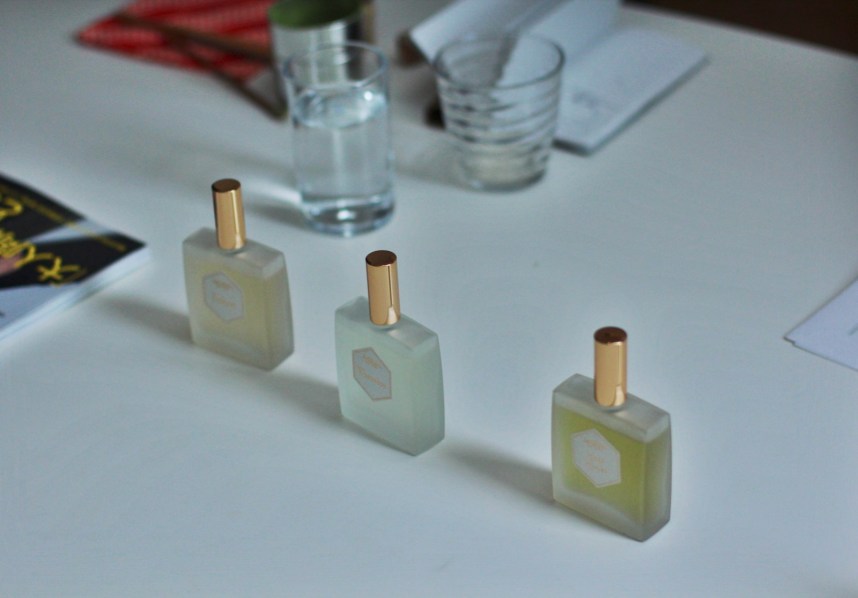DI SER Sasora and Shiragoromo Perfume Review With Chester Gibs

About half a year ago Yasuyuki Shinohara from the Hokkaido based company DI SER in Japan sent my perfume buddy Chester a free sample set of 8 Diser fragrances along with his purchase of Tsuki. He tested all the samples and was so enthusiastic that he thought it’d be a nice idea to share the pleasure of reviewing these special perfumes with me. I gladly accepted and we met up twice to sample the perfumes and had some tea with cakes on the side! We sampled all four of Diser’s agar wood collection perfumes Kyara, Shiragoromo, Hasunoito and Sasora.
In this review we will talk about Sasora and Shiragoromo.

Sasora (Agarwood Collection)
‘Sasora is another fragrant wood used in Kōdō*. This fragrance expresses the traditional flavor of ancient Japan. This perfume, extracted from Kyara, Agarwood and blended with Japanese yuzu, is finished as a suitable scent for Japanese traditional clothing and kimono.’ ( text from Official DI SER website)
Notes: Agarwood (oud), Yuzu (citrus fruit), Rosewood, Patchouli, Sandalwood, Camphor

Esperessence: ” Sasora is both fresh and dirty. It calmed and alerted me at the same time and would be excellent for those moments when you need both of these qualities. For example when you are taking an exam, having an important meeting or job interview. When I wore Sasora on my skin it became slightly powdery and feminine leaving an elegant impression. Sasora does not smell seamlessly blended and more botanical which is probably due to the fact only essential oils are used in DI SER compositions and not aroma chemicals.”

Chester: “Sasora is a subtle perfume with a most pleasant fresh and green opening. Through the fresh yuzu burst in the opening you can smell the patchouli. Perhaps it’s the ‘tingling’ effect this one has on my skin but I find the fragrance to be calming yet alert at the same time. Sasora becomes more woody and soft after a while.”

Shiragoromo (Agarwood Collection)
‘Shira Goromo means white cloth. In Japan, white is a sacred color, representing purity and cleanliness. This is a perfume that represents the “beauty” of innocence, using the white flowers Roses and Jasmine. Balance has been created by adding Kyara and Agarwood to the Jasmine and Roses.’ (Text from Official DI SER website)
Notes: Agarwood (oud), Yuzu (citrus fruit), Jasmine Sambac, Jasmine Grandiflorum, Rose Absolute, Spikenard
Fragrance family: Oriental/Floral/Woody (according to DiSer website)
Esperessence: ” When I first scented Shiragoromo woody notes and uplifting citrus fruit evoked a relaxing and activating feeling. The woody notes could be from the Spikenard or its combination with Agarwood. Spikenard oil (botanical name: nardostachys jatamansi) was traditionally used to uplift the mood and stimulate relaxation. Shiragoromo gave me the impression of smelling incense which is probably due to the spikenard which is not surprising as it is used to make incense. The ancient Egyptians already used to make incense with spikenard. Shiragoromo smelled like a room fragrance to me. I would gladly use this fragrance at home to evoke a relaxing atmosphere. It scented quite special as it does not smell like anything I have scented before. ”

Chester: ” Lime ,jasmine ,Agarwood, spikenard.This is just lovely! Delicate, almost a fresh neroli feel to it, maybe its the right blending of the lime and the jasmine with the other ingredients. It is uplifting and cheerful, certainly a perfume that moves me. I made a drawing while wearing this a few days ago (see painting above) I wanted to create an image of plant like hands spreading perfumed snow – that is what this perfume evoked when I smelled it during my drawing process. Shiragoromo is a beautiful perfume- oriental citrus, but certainly also floral enough. And it is a scent that makes me feel positive!”

Thanks Yasuyuki Shinoohara for your kind service and thank you Chester for sharing your perfume passion with me!
Visit the DI SER website here
Check out Chester’s blog Pencils and Perfume:
*Kōdō: explaining Kōdō in a few sentences does not do justice to the art of appreciating Japanese incense. You can watch more about the elegant art of enjoying or listening to aromatic woods in this interesting short documentary, the part about Kōdō starts at minute 9 (Begin Japanology: The Fragrances of Japan)
Photographs were made by me and the painting by Chester.







